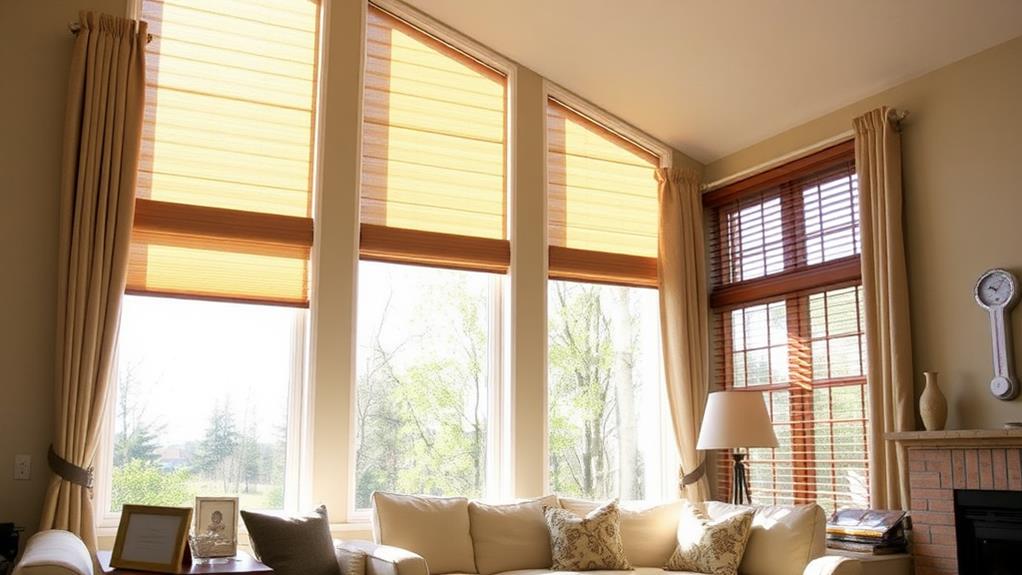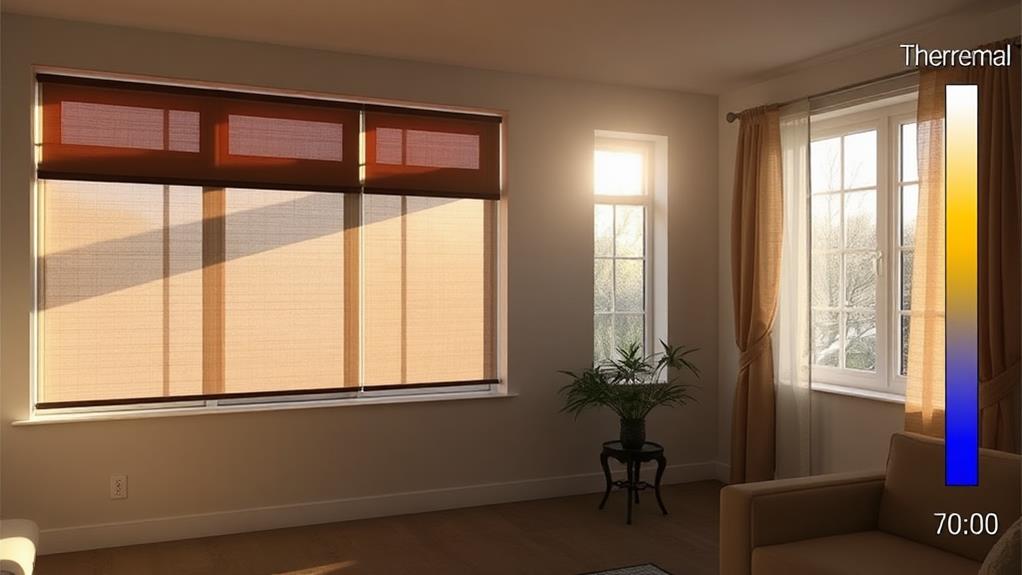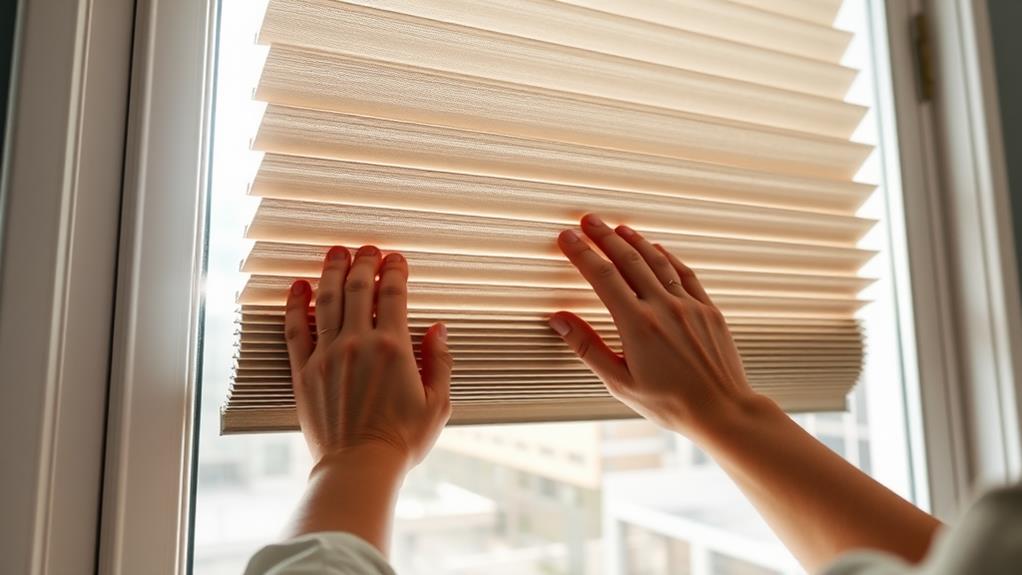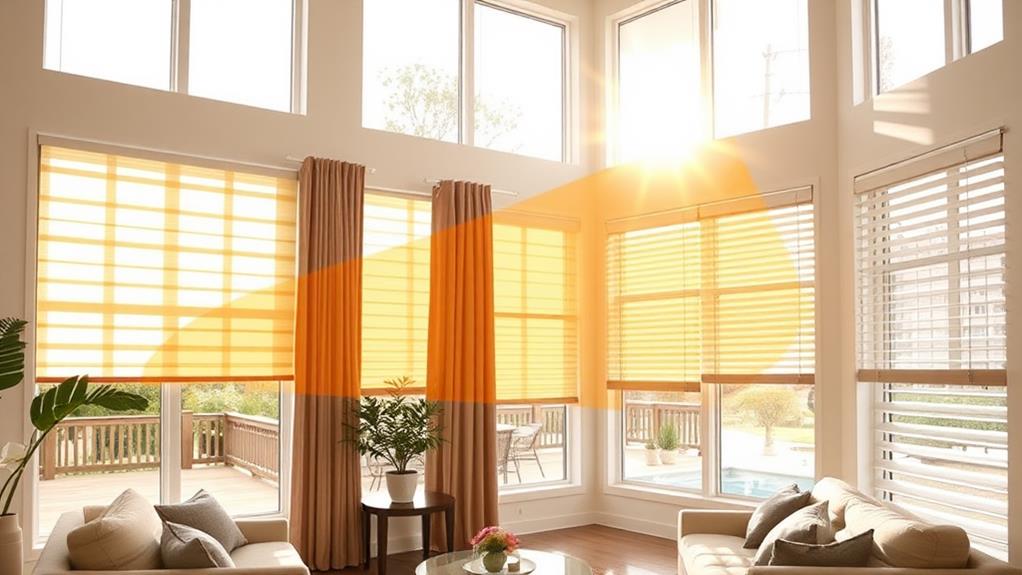Energy-efficient window treatments like blinds, curtains, and shades can significantly reduce your home's energy costs while improving comfort. Blinds offer precise light and airflow control, heavy curtains provide excellent insulation, and cellular shades trap air for an effective thermal barrier. When choosing treatments, consider your climate, window orientation, and home design. Look for options with high R-values for better insulation. You'll find various types, including insulated curtains, honeycomb shades, and plantation shutters, each offering unique benefits. These treatments not only save energy but also enhance privacy, reduce noise, and protect your furniture from sun damage. Dive deeper to discover which options best suit your needs and maximize your home's efficiency.
Understanding Energy-Efficient Window Treatments

Understanding the basics of energy-efficient window treatments is crucial for homeowners looking to reduce their energy bills and improve their home's comfort. These treatments work by creating an additional barrier between your indoor space and the outside environment, helping to regulate temperature and reduce heat transfer.
You'll find that energy-efficient window treatments come in various forms, including blinds, curtains, and shades. Each type offers unique benefits and can be tailored to your specific needs. Blinds, for instance, allow you to control light and airflow precisely, while heavy curtains provide excellent insulation during colder months. Cellular shades, with their honeycomb design, trap air to create an effective thermal barrier.
When choosing energy-efficient window treatments, consider factors such as the climate in your area, the orientation of your windows, and your home's overall design. You'll also want to pay attention to the R-value, which measures thermal resistance. The higher the R-value, the better the insulation properties. By selecting the right window treatments, you can significantly reduce your energy consumption and create a more comfortable living space year-round.
Types of Insulating Window Coverings
Now that you're familiar with the concept of energy-efficient window treatments, let's explore the specific types of insulating window coverings available. Cellular shades, also known as honeycomb shades, are among the most effective insulators. Their unique design traps air in individual cells, creating a barrier against heat transfer.
Roman shades, when lined with insulating material, offer both style and energy efficiency.
Insulated curtains or drapes are another popular option. These heavy, often multi-layered window treatments can significantly reduce heat loss in winter and heat gain in summer. Look for curtains with thermal backing or interlining for maximum insulation.
For a sleek, modern look, consider insulating window films. These transparent adhesive sheets can be applied directly to your windows, reducing heat transfer without obstructing your view.
Plantation shutters, while more permanent, provide excellent insulation when closed. They're particularly effective in hot climates, as they can reflect sunlight and keep interiors cool.
Lastly, don't overlook the power of layering. Combining different window treatments, such as shades with curtains, can create an even more effective insulating barrier while adding depth to your room's design.
Benefits of Thermal Window Treatments

Thermal window treatments offer a multitude of benefits that extend far beyond mere aesthetics. You'll notice an immediate improvement in your home's energy efficiency, as these coverings act as a barrier against heat loss in winter and heat gain in summer. This translates to lower energy bills and a more comfortable living environment year-round.
You'll appreciate the enhanced privacy these treatments provide, allowing you to enjoy your home without worrying about prying eyes. They also offer excellent light control, giving you the ability to adjust the amount of natural light entering your space. This feature can help protect your furniture and flooring from sun damage and fading.
Thermal window treatments can significantly reduce outside noise, creating a quieter, more peaceful indoor environment. They're especially beneficial if you live in a busy urban area or near traffic. Additionally, these treatments can increase your home's resale value, as energy-efficient features are increasingly attractive to potential buyers.
Seasonal Considerations for Window Treatments
Choosing the right window treatments for each season can maximize their energy-saving potential and enhance your home's comfort. In winter, opt for heavy, insulating curtains or cellular shades to trap warm air inside. Keep them open during sunny days to let in natural heat, and close them at night to prevent heat loss. For south-facing windows, consider using reflective blinds to bounce sunlight deeper into your rooms.
During summer, use light-colored, reflective treatments to deflect heat and reduce solar gain. Exterior shades or awnings are particularly effective at blocking sunlight before it enters your home. For east and west-facing windows, install adjustable treatments like venetian blinds or shutters to control light and heat throughout the day.
In spring and fall, choose versatile options that allow you to adapt to changing temperatures. Layered treatments, such as combining sheer curtains with heavier drapes, offer flexibility. You can also use motorized or smart treatments that automatically adjust based on time of day or outdoor conditions. Remember to consider your local climate and the specific orientation of each window when selecting seasonal treatments. By tailoring your approach, you'll optimize energy efficiency year-round.
Installation and Maintenance Tips

For optimal performance of your energy-efficient window treatments, proper installation and regular maintenance are crucial. When installing blinds, curtains, or shades, ensure they're mounted as close to the window as possible to create an effective air barrier. Use appropriate hardware and follow manufacturer instructions carefully to avoid gaps that could compromise energy efficiency.
Regularly clean your window treatments to maintain their effectiveness. Vacuum or dust blinds and shades weekly, and wash fabric curtains according to care instructions. For cellular shades, use compressed air to remove dust from the honeycomb cells. Inspect for damage or wear, and repair or replace as needed to maintain energy efficiency.
Lubricate moving parts of blinds and shades annually to ensure smooth operation. Check seals and weatherstripping around windows, replacing them if they're worn or damaged. Adjust treatments seasonally to maximize energy savings – open them during sunny winter days for solar heat gain and close them on hot summer days to block heat.
Choosing the Right Energy-Saving Options
With your window treatments properly installed and maintained, it's time to explore the most effective energy-saving options for your home. Consider cellular shades, which create air pockets to insulate windows and reduce heat transfer. They're available in single, double, or triple-cell designs, with more cells offering greater insulation.
For maximum energy efficiency, opt for insulated curtains or drapes with thermal lining. These heavy fabrics help block drafts and retain heat in winter while keeping your home cooler in summer. Alternatively, solar shades can reflect sunlight and reduce heat gain without completely blocking your view.
If you're looking for versatility, choose layered window treatments. Combine sheer curtains with blackout panels or pair roman shades with side panels. This approach allows you to adjust light and temperature control throughout the day.
Don't forget about exterior options like awnings or shutters. They can significantly reduce solar heat gain in summer, lowering your cooling costs. For a high-tech solution, consider smart blinds or shades that automatically adjust based on sunlight and temperature, optimizing your home's energy efficiency year-round.
Conclusion
As you've journeyed through the world of energy-efficient window treatments, you've unlocked the secret to a cozier, more economical home. Like Odysseus navigating treacherous waters, you're now equipped to steer your household towards energy savings. Don't let your windows become your home's Achilles' heel. Instead, arm yourself with the right blinds, curtains, or shades. They're your shield against extreme temperatures and high energy bills. Embrace these modern marvels and watch your comfort soar while your costs plummet.

